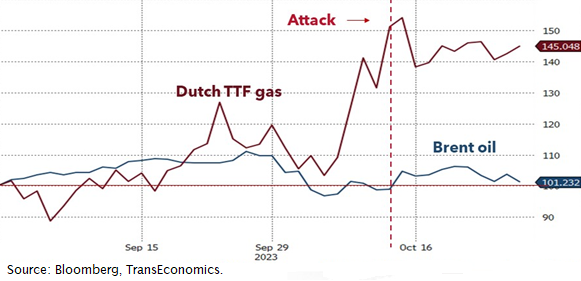Regional War in the Middle East is Still a Tail Risk
Genevieve Signoret & Delia Paredes
(Hay una versión en español de este artículo aquí.)
We have no words to describe the horror we feel over the Hamas terror attack on Israel and the resulting war in Gaza. To decide and tell you what it has meant for our global-macro view, we’ve had to force ourselves to switch off our agonized hearts to let our brains work.
While we do now see a regional war in the Middle East–one involving Iran–as a larger risk than we did a month ago, we continue to see such a conflict as a tail risk.
The war in Gaza poses the geopolitical risk that the war will become regional and in particular that Iran will become involved. To gauge this risk requires answering two questions: Was Iran involved in the Hamas attack on Israel? Second, is Iran likely to become directly involved in the resulting war in Gaza (or with the United States)? Second, is Iran now likely to enter into direct conflict with Israel (or the United States)?
We start with the first question. So far, the information available to us indicates no direct Iranian involvement in the Hamas attack on Israel. This implies that Iran’s involvement is indirect. Iran provides ongoing financing to Hamas. Also to Hezbollah in Lebanon, Shia militias in Iraq, and Houthis in Yemen. These facts are unchanged by recent events.
On question two, our thinking is in two steps: first we ask ourselves whether it would behoove Iran or Israel to engage in a direct military confrontation; second, we ask whether Iran, the United States, and Israel (unlike Russia) are likely to behave rationally.
We see no possible benefit to either Israel or the United States to engage directly with Iran and vice versa. Israel cannot stretch itself too thin militarily. After all, clearly it is not even keeping its borders with Gaza secure, and it must of course protect its remaining borders. Furthermore, its dependence for protection on the United States means it cannot ignore Biden, who is “counseling” caution.
In Iran’s case, given the Israel–U.S. alliance, direct involvement risks war with the United States and thus a world war. No one wins in a world war.
OK, you may respond, but your argument rests on logic. How can you be sure that the two sides will apply logic? After all, didn’t Putin act irrationally by invading Ukraine back in February 2022? And isn’t it clear that emotions are running high in Israel?
These are valid points. However, based on our reading of rhetoric from Iran, Israel, and the Arab states, we pick up no sign of the kind of Putin-like delusional thinking anywhere likely to lead to a world war.
Beside the rhetoric from both sides and whatever the press is able to find out from U.S. intelligence sources and report to the public, do we have any other kind of evidence?
Direct, no. But we can “free-ride” on the research of oil market analysts by looking the oil price responses to the conflict. We are a small research team, but oil prices are set by traders worldwide who have massive resources for research and powerful monetary incentives to get it right. Their collective views are expressed in world oil prices. And, as of the close of Thursday 26 October, whereas Dutch gas was up 41% since August 31 (Israel produces about 28 billion cubic meters of gas per year, of which it exports one third), Brent oil had risen mere 1.2%—hardly the kind of price movement one would expect if traders believed that war with Iran were about to break out.
Oil prices confirm our perception that the risk that the war in Gaza will turn regional is tiny; Dutch gas prices have jumped because Israel exports 1/3 of its output
Brent oil and Dutch TTF gas prices, 100 = 31 August 2023

You will recall from our September Quarterly that, back then, we identified a military confrontation between Israel and Iran as a tail risk. (This has been true, by the way, ever since we began publishing global macro scenarios, which is about 20 years ago.) When Hamas attacked Israel, provoking a war to break out in Gaza, our first research question was whether we should recategorize that risk from tail to pivotal. Our message today is that we have decided not to do so—we continue to see a direct Israel–Iran or United States – Iran military confrontation as a larger tail risk than before but still a tail risk.
Updated for clarity on 1 November 2023.

